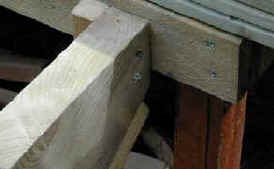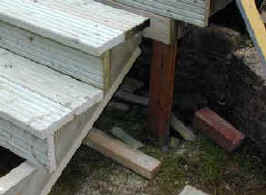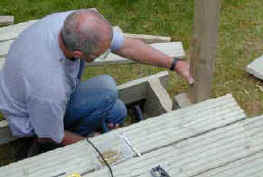Building A Deck Staircase - Decking project 9 -
Most raised decks need a set of steps or often a proper set of decking stairs to get access to and from the deck to a lower garden – or sometimes to a high level door – dependent upon where the deck fits to the house. Some houses at the rear garden have a floor level which is much higher than the garden – which sometimes slopes away from the house.
The examples on this page are of very basic deck steps – quite easily constructed using pre-made ‘stringers’ which will be sold at most builder merchant or your normal deck timber supplier. The stringers are pre-made, taking into account the rules and regulations for tread width and riser height which will be a necessary consideration if building controls are involved.
Decks can sometimes not be signed-off by a building control inspector if the dimensions for treads and risers and also the angle of the steps do not conform with building regulations. Basically the same criteria are adopted as for full staircases in the house. There is no different specification for deck staircases.
Simple single step from deck
Sometimes there is a single step required down from the deck to the garden. This is easily achieved by building a box frame from the joist timbers (6x2in – 150x50mm) and fixing deck boards to the surface. Aim for 12in 30cm depth which is normally ok for two standard deck widths. Even though it is just a simple single step, the box base will need to be secured into the ground – NOT free standing. Over time there will be wear under the fra,work, leading to an unstable, rocky step.
Building a Deck Staircase using Stringers
Building a deck staircase – or even a few steps - is invariably the most difficult part of the deck construction to get right. However small the set of steps are, safety should be the first consideration. This starts with proper construction giving a rigid project, and by ease of use which will be defined by the building regulations. Even if you do not need building control permission, it is as well to adhere to the rules and regulation relating the staircase provision and Steps will or should be accompanied by some type of handrail and again, there are regulations that need to be adhered to for handrails.

Decks higher than 90cm – 3ft off the ground will need a different approach to staircase building.

The support posts concreted into the ground will also provide a good non-giving surface on which to base your newels - assuming you are going to incorporate a balustrade or even a hand rail - IMPORTANT even for a few steps down - or up.

If your deckboards are not as wide as the standard 6in boards you should always have a full deckboard width at the tread leading edge, and any in-fills of differing width can be situated in the main depth of tread. Together with that, you will have to accommodate the 'give' in narrower boards when used on the treads. 150x40mmdeckboards can normally be used with a 90cm span. The give extra stability to the treads, it is a good idea to use an off-cut deck board or joist under the tread as a central strengthening extra.


Staircase ready for fixing of the newels. The overhanging treads will need to be cut in around the newel - or simply trimmed off flush with the stringer surface. Overhang looks better and can be further enhance by using a fascia deck board on both edges attached to the stringer.
<<< Back to
page 8 To Decking Project
page10>>>
<<<Back to Main Decking Project Page
Best Selling Gardening Products
Popular Gardening Sections

Problems
Identify Weeds in The Garden - How to deal with weeds. Diseases and Pest which harm your garden and plants, learn how to prevent, deter and erradicate your garden problems.
Garden Problems
Pruning
Pruning Guide. Shrubs flower better with correct pruning. Many illustrations and examples of what to do - and when. Includes evergreens, roses, flowering shrubs, spring flowering shrubs and pruning for stem effect. This is our most viewed and comprehensive section,
Pruning
Gardening Businesses
Gardening Businesses listed in the UK counties and USA states. County and State Listings of businesses involved in Garden supplies and services. If you wish to be added to the Directory, please send us your information. Having problems, use the search box
Businesses
Gardening
In this section you will learn about Gardening Basics, Containers, Landscaping, Propagation and Soil.
Gardening
Gardening Gifts
Gardening Gifts and Reviews, Read Before you Buy
- Gardening Gifts Ideas
- Gifts For Her
- Gifts For Men
- Power Tool Gifts
- Cheap Gifts
- Personalised Gifts
- Wildlife Gifts
- Family Gifts




